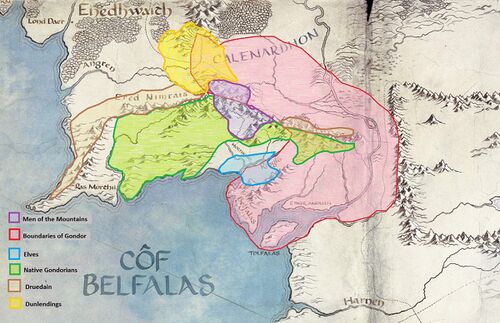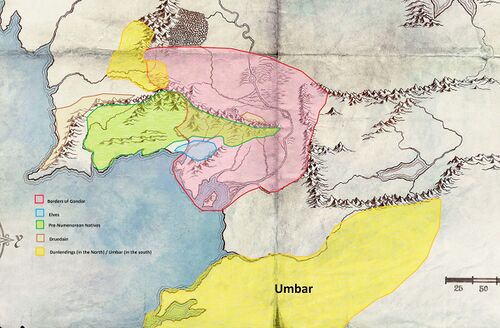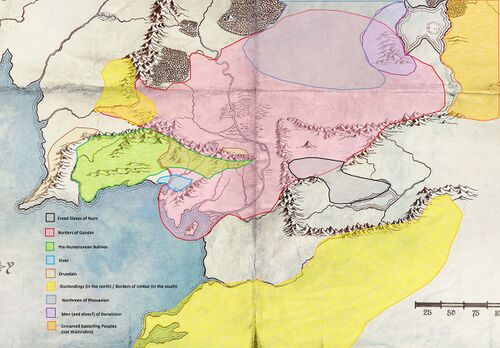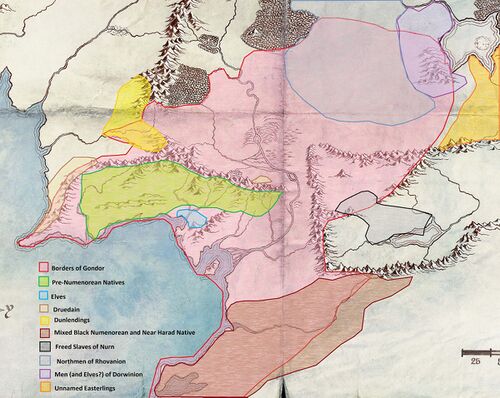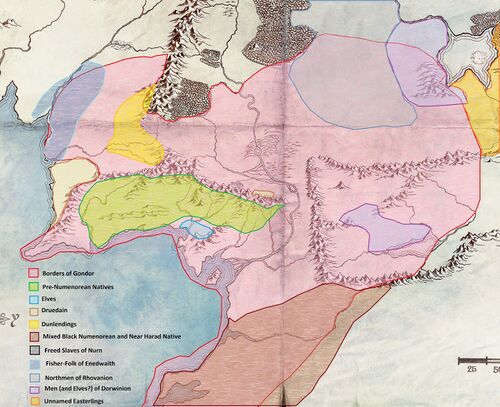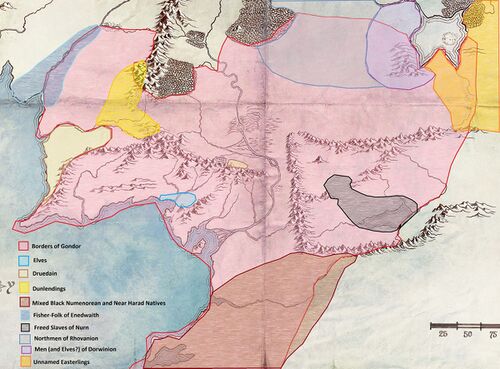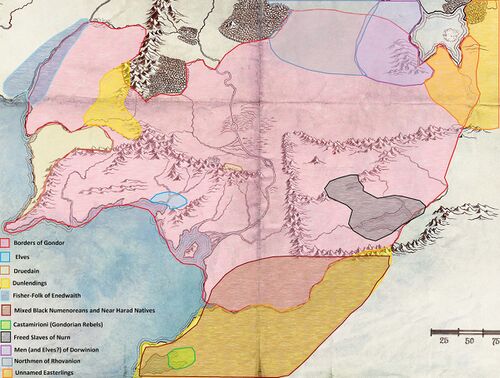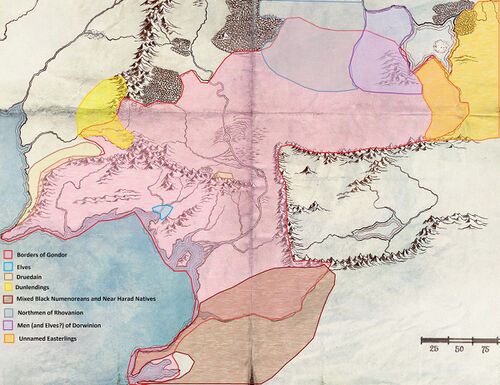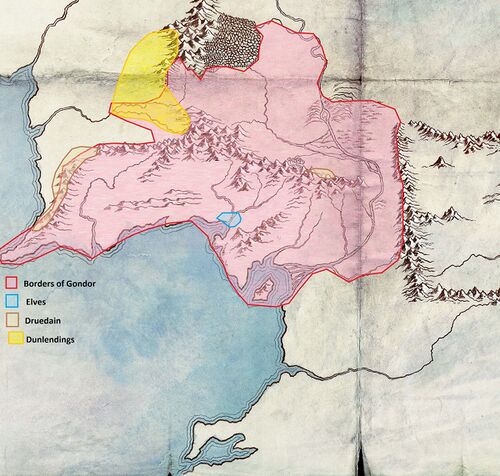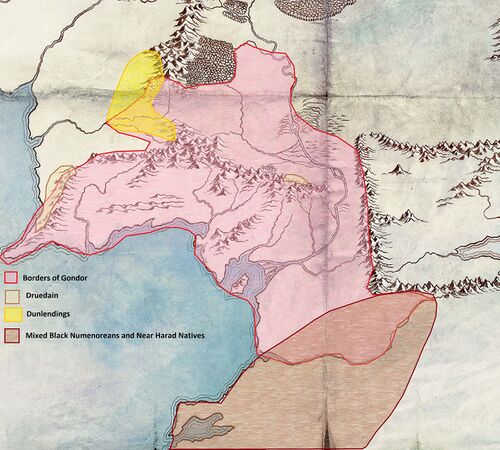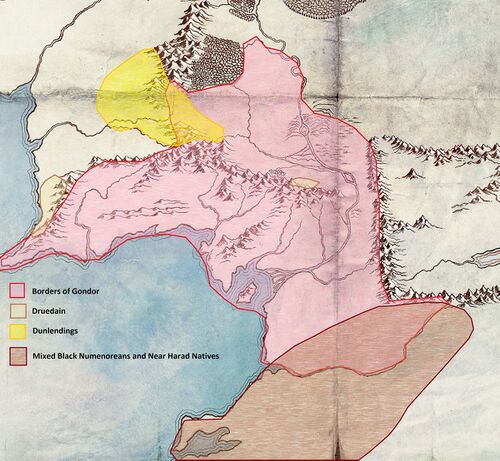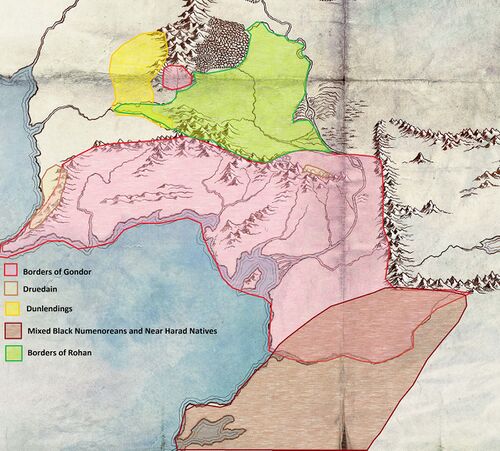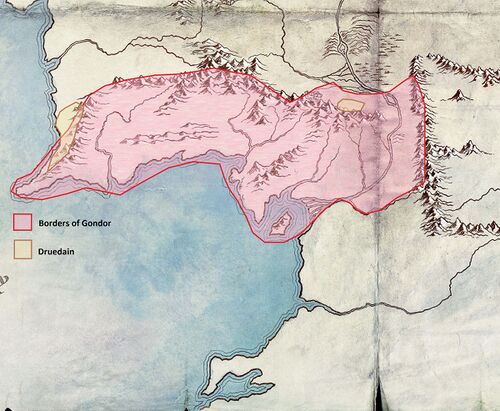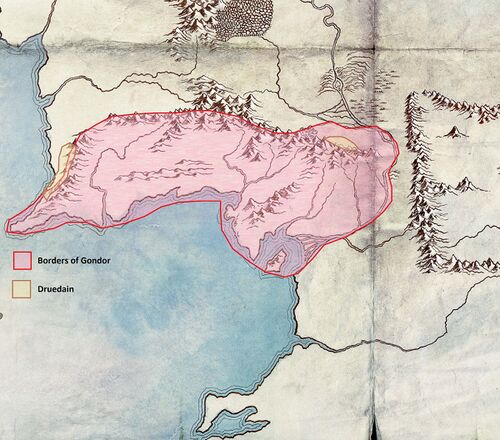| Gondor |
|---|
 Flag |
The Kingdom of Gondor is the greatest realm of Men in the west of Middle-earth at the end of the Third Age. It was founded by the Exiles of Númenor led by Elendil, who established the Realms in Exile of Arnor and Gondor in S.A. 3320 (3127 years ago).
Summary
Main article: History of Gondor
Gondor was founded by the brothers Isildur and Anárion, exiles from the downfallen island kingdom of Númenor. Along with Arnor in the north, Gondor, the South-kingdom, served as a last stronghold of the Men of the West. After an early period of growth, Gondor gradually declined as the Third Age progressed, being continually weakened by internal strife, plague, and conflict with the allies of Mordor. 956 years ago, the last king of Gondor, Eärnur, passed into Minas Morgul to answer the challenge of the Witch-king, and was never seen again. From that time onward, Gondor has been ruled by the Stewards in the kings' stead. The kingdom's principalities and fiefdoms still pay deference to the absent king by showing their loyalty to the Stewards of Gondor.
Climate and ecology
The average annual temperature in Gondor is 13 °C, with wide variation across altitude and region. Anórien is mostly humid continental, with warm to hot (and often humid) summers and cold winters. Lebennin is mostly humid subtropical, with cool winters and hot summers. The coastal areas of Anfalas, Belfalas and most of the South generally fit the Mediterranean climate stereotype, with hot, sometimes very hot and dry summers and mild, wet winters.
Conditions on the coast are different from those in the interior, particularly during winter months when the higher altitudes tend to be cold, wet, and often snowy. The coastal regions have mild winters and warm and generally dry summers, although lowland valleys can be quite hot in summer. Average winter temperatures vary from 0 °C in the White Mountains to 10 °C in Tolfalas, and average summer temperatures range from 20 °C to over 25 °C. Winters can vary widely across the country with lingering cold, foggy and snowy periods in the north and milder, sunnier conditions in the south. Summers can be hot and humid across the country, particularly in the south, while northern and central areas can experience occasional strong thunderstorms from spring to autumn.
The varied ecological biomes of Gondor are detailed in the regional pages.
Architecture
Architectural epochs and styles
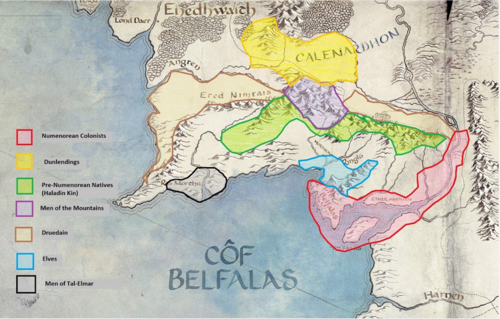
The Tal-Elmar/Agar & Udul location is theoretical. It could also be near the site of Linhir or Ethir Anduin, before the Númenoreans settled in those regions.
Pelargir is founded, and various satellite settlements around it. Trade with Edhellond, encounters with the Men of the Mountains (dead men) and other Tall Men and such who lived in the area.
Style: Old Númenórean
-3000-2500 years old
This is the original Númenórean style, or the nearest approximation of it to be found in current-day Middle-earth. Numerology would be considered important in architecture in this period, with various references to Númenor being very apparent due to Minas Tirith's foundation as a Faithful stronghold in Middle-earth (for example, 5 is a sacred number, in memory of the 5 spurs of Meneltarma).
Simple seabird motifs were prominent. These were most prominent in crenellations on walls, and on towers or housetops in older buildings. Arches in this architecture were minimal except in megalithic contexts, and a Greek-style post-and-beam method was preferred. Triangular arches were reserved for tombs or places of spiritual importance, as they are symbolic of Meneltarma. Windows were typically elongated, and triangular on larger buildings. They often came in groups of 3 or 5. Pillars in this time were top-heavy like those of Knossos, but with large, grand capitals. These often appeared in colonnade.
This style only appears in some of the original infrastructure and manors.
Notes
- Early cities would be founded around colonial centres/manor or palace complexes, nobles from Númenor’s old established mansions etc. from a pre-faithful time perhaps as well?
- Pelargir and Dor-en-ernil are said to have been founded as explicitly settlements by and for the Faithful after the dichotomy between King's Men and Faithful had emerged. The logging issue had taken place centuries earlier starting under Aldarion before the Rings of Power, and was a primary issue mainly in Enedwaith and Minhiriath.
- The settlers of Pelargir are explicitly said to have not interacted with the Men of the White Mountains for some years after the founding of the city, and when they did so it was friendly. It is doubted that enslavement or logging were thus of primary concern to the settlements in Gondor. It was primarily a Puritans/Pilgrims situation of religious persecution as well as political asylum, combined with a desire to dwell nearer to the Elves and a need to keep an eye on the doings of Sauron nearby.
- Tower complex in this period facing westward in their palaces (toward the holy mountain in Númenor)
- Palaces centred around logging or trade/enslavement would have grown towns around them.
- Good equivalent for Pelargir would be Boston; the Faithful founded the city due to persecution, but unlike Boston were backed by several great families from Númenor.
Architecture begins to diverge from Númenor as Gondorian culture settles into its role as an expansionist empire. Large Egyptian, Babylonian, and Cyclopean architecture with Roman/Greek elements, perhaps even more so than before. Large brick surfaces and domes might be more common in this period as well. Cities grew around their palaces similar to how in Mesopotamia cities grew around temple complexes.
Fall of Númenor. Gondor is founded. Isengard, Erech, Osgiliath, Minas Ithil and Minas Anor are founded/built. First settlements begin, and the setting up of governance structures. Territory of Gondor is Calenardhon, Ithilien, Anorien, Pelennor, Lossarnach, Belfalas, and Lebennin.
Style: Old Númenórean
-3000-2500 years old
This is the original Númenórean style, or the nearest approximation of it to be found in current-day Middle-earth. Numerology would be considered important in architecture in this period, with various references to Númenor being very apparent due to Minas Tirith's foundation as a Faithful stronghold in Middle-earth (for example, 5 is a sacred number, in memory of the 5 spurs of Meneltarma).
Simple seabird motifs were prominent. These were most prominent in crenellations on walls, and on towers or housetops in older buildings. Arches in this architecture were minimal except in megalithic contexts, and a Greek-style post-and-beam method was preferred. Triangular arches were reserved for tombs or places of spiritual importance, as they are symbolic of Meneltarma. Windows were typically elongated, and triangular on larger buildings. They often came in groups of 3 or 5. Pillars in this time were top-heavy like those of Knossos, but with large, grand capitals. These often appeared in colonnade.
This style only appears in some of the original infrastructure and manors.
Control is solidified over the native peoples, except for the men of Dunharrow who are shunned for their betrayal. The Hornburg possibly constructed during this time.
Style: Old Númenórean
-3000-2500 years old
This is the original Númenórean style, or the nearest approximation of it to be found in current-day Middle-earth. Numerology would be considered important in architecture in this period, with various references to Númenor being very apparent due to Minas Tirith's foundation as a Faithful stronghold in Middle-earth (for example, 5 is a sacred number, in memory of the 5 spurs of Meneltarma).
Simple seabird motifs were prominent. These were most prominent in crenellations on walls, and on towers or housetops in older buildings. Arches in this architecture were minimal except in megalithic contexts, and a Greek-style post-and-beam method was preferred. Triangular arches were reserved for tombs or places of spiritual importance, as they are symbolic of Meneltarma. Windows were typically elongated, and triangular on larger buildings. They often came in groups of 3 or 5. Pillars in this time were top-heavy like those of Knossos, but with large, grand capitals. These often appeared in colonnade.
This style only appears in some of the original infrastructure and manors.
Architectural development/beautification period. Palaces were expanded and grew in power in this period; oldest city centres were embellished and new cities were expanded with grid format. Architecture skill was most likely still top notch due to Minas Tirith probably gaining its black wall around this time from excess material while carving Orthanc several hundred years prior. The Egyptian style develops into something more Cretan, Greek/Roman elements creeping in with the assimilation of new peoples into the empire. Etruscan architecture enters the fold with the assimilation of Andrast and Blackroot etc., which by this point would have been congruent to Númenorean culture at least in terms of development.
Easterlings first invade, are driven back, and new territory is added to Gondor across the Anduin. (Dagorlad, Emyn Muil, Dorwinion, and Southern Rhovanion) Gondor and Umbar begin to have more amenable relations, trading and becoming allies for a time.
Style: Expansionist Neo-Númenórean
- 2500-1700 years old
This period saw an influx of foreign artisans and ideas as the kingdom grew. Though it retained the Old Númenorean simplicity, the style became more ornate and experimental. More Classical-era characteristics , such as rounded arches on windows and doorways, began to appear. This also included the emergence of arched colonnades, though the post-and-beam method was still common. From this point onward, pillars began shifting to bottom-heavy, representing the start of the slow decline. The design of their capitals remained about the same, though.
Sun imagery in architecture rose to prominence during this period, representative of Gondor as a rising empire as well as the region’s name (Anórien means “Sun-land” in Sindarin). The seabird motifs were still commonplace as well, though somewhat simpler and more abstract.
There are very few surviving structures that use this architectural style; most have been modified or added on to in later years.
Control of the coasts of Gondor is solidified west to the Cape of Andrast and south to the lands of Umbar (we don’t know how far south; some amount of Near Harad was also owned by Gondor at this point, but it’s unknown how much). In the reign of the first Ship King we have the marriage to the noblewoman of Umbar, showing an attempt at further cementing the alliance with the other realm in exile. However, after the disastrous failure of the marriage, the relations between the realms grew bitter and the kingdom of Umbar was conquered by Hyarmendacil I, one of the ship kings.
Style: Expansionist Neo-Númenórean
- 2500-1700 years old
This period saw an influx of foreign artisans and ideas as the kingdom grew. Though it retained the Old Númenorean simplicity, the style became more ornate and experimental. More Classical-era characteristics , such as rounded arches on windows and doorways, began to appear. This also included the emergence of arched colonnades, though the post-and-beam method was still common. From this point onward, pillars began shifting to bottom-heavy, representing the start of the slow decline. The design of their capitals remained about the same, though.
Sun imagery in architecture rose to prominence during this period, representative of Gondor as a rising empire as well as the region’s name (Anórien means “Sun-land” in Sindarin). The seabird motifs were still commonplace as well, though somewhat simpler and more abstract.
There are very few surviving structures that use this architectural style; most have been modified or added on to in later years.
The realm was both prosperous and peaceful. Maximum territorial extent of Gondor.
Style: Expansionist Neo-Númenórean
- 2500-1700 years old
This period saw an influx of foreign artisans and ideas as the kingdom grew. Though it retained the Old Númenorean simplicity, the style became more ornate and experimental. More Classical-era characteristics , such as rounded arches on windows and doorways, began to appear. This also included the emergence of arched colonnades, though the post-and-beam method was still common. From this point onward, pillars began shifting to bottom-heavy, representing the start of the slow decline. The design of their capitals remained about the same, though.
Sun imagery in architecture rose to prominence during this period, representative of Gondor as a rising empire as well as the region’s name (Anórien means “Sun-land” in Sindarin). The seabird motifs were still commonplace as well, though somewhat simpler and more abstract.
There are very few surviving structures that use this architectural style; most have been modified or added on to in later years.
Cities began expanding at a more frantic rate, less city planning. No great architectural projects at this time in the heartland, though perhaps monuments etc. were set up in conquered lands. This period would further debase architecture from its original splendour; the old methods still were recorded probably, but shelved away due to war on the rise. Buildings from this time period were probably crappy and either remodeled later, or ruined/unimportant for inhabited Gondor. It’d more or less be a continuation from Epoch III.
The native pre-Numenoreans around this time are fairly well assimilated into Gondor proper, but retain unique styles and culture, especially the further west one goes. Renewed Easterling invasions, and with the help of the Northmen (some subjects of Gondor in southern Rhovanion and some in the allied kingdoms in the northern part of rhovanion) the Easterlings are driven back and Romendacil II destroys their settlements “east of the Sea of Rhun” which indicates that there was an unnamed group of easterlings settled by the Sea of Rhun at this point on the eastern shores. Some interesting implications here but that's another story. The king fortified the western shore of the Anduin up to the River Limlight, and had the Pillars of the Argonath built above Nen Hithoel. Romendacil’s rule and his son’s ramps up the tension.
Style: Royal Neo-Númenórean
1800-900 years old
These centuries were marked by both glory and ruin. The architecture from this time reflects that, with the opulence of design reaching its peak. Many additions would be pointless uses of enormous wealth, such as blind arcades randomly added on to buildings and towers that serve no practical purpose.
One major stylistic point that emerged during this time was the use of window pairs rather than groups of 3 or 5, representing the introduction of the Steward into the cultural zeitgeist. This trend can also appear where additions were made to older buildings. The use of bottom-heavy pillars was also fully cemented by this time.
Many of the larger insula projects of Minas Tirith were built in this period, and were maintained well into the stewards’ reign. The structure of these insulae would be quite varied, accommodating the space as needed.
A large portion of buildings in Minas Tirith, as well as the smaller towns, use this style.
Political strife and infighting on the part of multiple periods in Gondor’s history; buildings if added on would have been more frantic with architecture less pristine, mostly crammed in and around cities in order to expand space; parts of cities raided/razed, which could account for the loss of ancient Númenorean methods in order to build (i.e. Orthanc, Minas Tirith, etc.) Buildings added would have been mediocre at best, straying from the planned cities of earlier periods. The loss of architectural tech would have also firmly trapped the Gondorians within their new weird Greek/Roman creole mish-mash, with very little influence left of the previous Egyptian periods.
Civil war, Umbar rebellion. Gondor loses Umbar and the lands of Harad.
Style: Royal Neo-Númenórean
1800-900 years old
These centuries were marked by both glory and ruin. The architecture from this time reflects that, with the opulence of design reaching its peak. Many additions would be pointless uses of enormous wealth, such as blind arcades randomly added on to buildings and towers that serve no practical purpose.
One major stylistic point that emerged during this time was the use of window pairs rather than groups of 3 or 5, representing the introduction of the Steward into the cultural zeitgeist. This trend can also appear where additions were made to older buildings. The use of bottom-heavy pillars was also fully cemented by this time.
Many of the larger insula projects of Minas Tirith were built in this period, and were maintained well into the stewards’ reign. The structure of these insulae would be quite varied, accommodating the space as needed.
A large portion of buildings in Minas Tirith, as well as the smaller towns, use this style.
There’s a lot of little conflicts. Hyarmendacil II defeats the Haradrim, possibly gaining some territory back in Near Harad or Harondor. Castamir’s descendents kill one of the kings in a raid on Pelargir. Eventually Umbardacil captures Umbar and razes it, killing Castamir’s descendants. Also there’s the Great Plague, and all that stuff is bad for Gondor. Gondor loses its loose hold on Enedwaith, and Tharbad as well.
Style: Royal Neo-Númenórean
1800-900 years old
These centuries were marked by both glory and ruin. The architecture from this time reflects that, with the opulence of design reaching its peak. Many additions would be pointless uses of enormous wealth, such as blind arcades randomly added on to buildings and towers that serve no practical purpose.
One major stylistic point that emerged during this time was the use of window pairs rather than groups of 3 or 5, representing the introduction of the Steward into the cultural zeitgeist. This trend can also appear where additions were made to older buildings. The use of bottom-heavy pillars was also fully cemented by this time.
Many of the larger insula projects of Minas Tirith were built in this period, and were maintained well into the stewards’ reign. The structure of these insulae would be quite varied, accommodating the space as needed.
A large portion of buildings in Minas Tirith, as well as the smaller towns, use this style.
Some expansion again, but nothing is as good as before. Probably this is the architectural shift in which Gondor became more Byzantine/late Roman rather than maintaining its previous path; in the present day, this would probably be most common in cities.
Gondor begins to lose its eastern territories across the Anduin. Its hold on Dorwinion and southern Rhovanion is broken, and the Wainriders settle in the plains, enslaving the native Northmen. There is some small peace won as Calimehtar defeats a large army of the Wainriders on the Dagorlad with help from a slave revolt and the Eotheod, but no territory is reconquered. Even the later victory of Earnil does not win Gondor back any territory, and their reach still ends at the Dagorlad.
Style: Royal Neo-Númenórean
1800-900 years old
These centuries were marked by both glory and ruin. The architecture from this time reflects that, with the opulence of design reaching its peak. Many additions would be pointless uses of enormous wealth, such as blind arcades randomly added on to buildings and towers that serve no practical purpose.
One major stylistic point that emerged during this time was the use of window pairs rather than groups of 3 or 5, representing the introduction of the Steward into the cultural zeitgeist. This trend can also appear where additions were made to older buildings. The use of bottom-heavy pillars was also fully cemented by this time.
Many of the larger insula projects of Minas Tirith were built in this period, and were maintained well into the stewards’ reign. The structure of these insulae would be quite varied, accommodating the space as needed.
A large portion of buildings in Minas Tirith, as well as the smaller towns, use this style.
This period is marked by renewed relations with Arnor, and Earnur’s aid in the defeat of Angmar. However, on Gondor’s domestic front there is not much development, and their territory does not change, neither is there much conflict on their borders. The main thing for Gondor was the loss of Minas Ithil in the year 2002, when the Nazgul retook it. Osgiliath became abandoned at this time, and much of Ithilien became more dangerous. The death of the last king in Minas Morgul marked the end of the Kingship of Gondor. This would likely be one of the single most significant cultural events for Gondor. During this period, Imrazor of Belfalas wedded Mithrellas, the Elf of Lorien. Edhellond was also finally abandoned in 1981.
Style: Royal Neo-Númenórean
1800-900 years old
These centuries were marked by both glory and ruin. The architecture from this time reflects that, with the opulence of design reaching its peak. Many additions would be pointless uses of enormous wealth, such as blind arcades randomly added on to buildings and towers that serve no practical purpose.
One major stylistic point that emerged during this time was the use of window pairs rather than groups of 3 or 5, representing the introduction of the Steward into the cultural zeitgeist. This trend can also appear where additions were made to older buildings. The use of bottom-heavy pillars was also fully cemented by this time.
Many of the larger insula projects of Minas Tirith were built in this period, and were maintained well into the stewards’ reign. The structure of these insulae would be quite varied, accommodating the space as needed.
A large portion of buildings in Minas Tirith, as well as the smaller towns, use this style.
Not much happens with Gondor during this time. They are able to grow and recuperate from the Wainrider period, as well as expand their cities and such under the rule of the first stewards, who were more concerned with governance than with war and strength of arms, as the last two kings had been. Dol Amroth was founded in 2076 by Galador, the son of Imrazor, who moved his family’s seat from Linhir to the western promontory. The largest change is the slow depopulation of Calenardhon, and the incursions of the Dunlendings over the Isen into the Westfold. Tharbad is ruined and the Dunlendings cease to be subjects of Gondor.
Style: Stewards' Neo-Númenórean
- 900-0 years old
As the kingdom declined under the reign of the Stewards, the architectural style became much simpler and utilitarian, though still possessing a graceful and homely quality. The layouts of these houses are less standardized than in previous eras, featuring more wayward and imperfect interior spaces. Overall it largely resembles medieval Italy.
The quality of building materials also saw a sharp decline during this time. Many houses use recycled stones and poor masonry work, also often featuring timber framing. The walls are typically plastered or whitewashed.
The vast majority of buildings in Anórien use this style, especially outside of Minas Tirith.
Ithilien was overrun by Uruk-hai in 2475, and this force managed to capture Osgiliath for a time before being repelled. However, the remainder of Osgiliath's civilian population never returned. Denethor I had the Rammas Echor constructed soon after this assault to ensure the safety of the Pelennor Fields. This period also marks the creation of Rohan and the subsequent development of that nation. Gondor becomes threatened by the Balcoth who dwelt in southern Rhovanion, and Cirion rebuilds the forts along the Anduin in the Wold. After the invasions of the Balcoth over the Undeeps, the Rohirrim come to the aid of Gondor and are given Calenardhon as their province, except for the valley of Isengard. However, during this period the Dunlendings took control of Isengard and wrested it from the control of Gondor. It is also said that after the Watchful Peace Gondor never again had full peace on its borders, implying that Ithilien, Harondor, and the coastal cities were always under threat from Minas Morgul, Rhovanion, Harad, and Umbar.
Style: Stewards' Neo-Númenórean
- 900-0 years old
As the kingdom declined under the reign of the Stewards, the architectural style became much simpler and utilitarian, though still possessing a graceful and homely quality. The layouts of these houses are less standardized than in previous eras, featuring more wayward and imperfect interior spaces. Overall it largely resembles medieval Italy.
The quality of building materials also saw a sharp decline during this time. Many houses use recycled stones and poor masonry work, also often featuring timber framing. The walls are typically plastered or whitewashed.
The vast majority of buildings in Anórien use this style, especially outside of Minas Tirith.
This period marks the attacks by the Dunlendings, and Balcoth on Rohan and the Corsair attacks on all the southern provinces of Gondor. The Prince of Dol Amroth was killed in battle with the Corsairs, possibly suggesting a bitter fight in the city itself, while we can assume that Pelargir and Linhir and other port cities were hit hard by the assaults, as well as other unnamed settlements on the Langstrand. After dispelling the enemies, Saruman is given control of Isengard, and Gondor loses its northernmost territory. Gondor loses its grip on Harondor after the Battle of Poros, but hold Ithilien against the Haradrim. The realm now entirely consists of the lands south of the White Mountains, Anorien, and Ithilien.
Style: Stewards' Neo-Númenórean
- 900-0 years old
As the kingdom declined under the reign of the Stewards, the architectural style became much simpler and utilitarian, though still possessing a graceful and homely quality. The layouts of these houses are less standardized than in previous eras, featuring more wayward and imperfect interior spaces. Overall it largely resembles medieval Italy.
The quality of building materials also saw a sharp decline during this time. Many houses use recycled stones and poor masonry work, also often featuring timber framing. The walls are typically plastered or whitewashed.
The vast majority of buildings in Anórien use this style, especially outside of Minas Tirith.
Sauron declares himself openly in Mordor again, and Ithilien becomes a battleground, both from attacks from Mordor and from Harad. There is little time for peace or growth, and Gondor becomes increasingly desperate, losing control of Ithilien and the eastern bank of Osgiliath to the enemy, maintaining only guerrilla forces in Ithilien. Gondor defeats Umbar and burns the quays, but is unable to take the city. This brings us to present date (TA 3006).
Style: Stewards' Neo-Númenórean
- 900-0 years old
As the kingdom declined under the reign of the Stewards, the architectural style became much simpler and utilitarian, though still possessing a graceful and homely quality. The layouts of these houses are less standardized than in previous eras, featuring more wayward and imperfect interior spaces. Overall it largely resembles medieval Italy.
The quality of building materials also saw a sharp decline during this time. Many houses use recycled stones and poor masonry work, also often featuring timber framing. The walls are typically plastered or whitewashed.
The vast majority of buildings in Anórien use this style, especially outside of Minas Tirith.
Manors
Practically since the kingdom’s foundation, well-off Gondorian families have resided in manors. In rural settings they can be quite large and sprawling, while those in the towns and cities tend to be much more compact regardless of the owner’s wealth. The wealthiest families may own two or more homes of this sort, thus some can be shown to be unoccupied at the present time.
Basic and types of Manors
This, the manor culture is followed by residences of various social classes and occupational groups. You first have to understand who are the well-off people.
First, many of them base on landholdings some of which are inherited from remote past and some are fluidly dealed in. This is basic, relevant to all wealth classes and even to non-estate based occupation including merchants, governmental/military offices and diverse urban people. Alike, small landholders do exist through countries and in varied land sizes, thus forming a quite complex environment of ruralscape - but you shouldn't worry much about this as it's really abstract. To return, sizable landholders actively engage in making profit out of the holdings, and here Estate turns up.
Manor Architecture
Though the architectural style of these manors vary due to construction date and regional differences, they share the following common traits:
| ExpandManor components
|
| Courtyard(s)
|
Physical center of the complexes, present in all but the very smallest urban manors. Those are quite fluid in style; surrounded with colonnades or left open-air, compact atrium(which can go over 3-4 stories) or spacious peristyle. Hallways, rooms and stairs are usually directly or indirectly accessed from the courtyards.
|
Vestibule
|
A small room leading into a larger space - an entrance hall.
|
Reception
|
A room or a hall. This can take the form of an Audience Hall (Hall of Pillars): These can be quite large, particularly when the lord of the manor holds a large amount of political power. There’d be another reception if the manor is detached from them. In terms of in-game creativity, this is where you can have a full play with architecture.
|
Solma (Hall of Fire)
|
Must be present in all manors. This room features a central hearth and serves as a space for formal socializing. Proper manors also contain a second solma for the private affairs of the homeowner (or multiple solmar in 'Palaces').
|
Dining Room
|
The size and grandeur of this room varies greatly, depending on the size of the manor itself. A manor of a decent noble almost always has 2 dinings at a minimum, a bigger one for dinner and banquet, the other for ordinary meals and private banquet.
|
Kitchen
|
Operated by servants (and maybe a cook), located nearby a side entrance and outside, if available.
|
| Baths
|
Usually much smaller than public bath houses, often a single room in urban settings. The changing area, which may or may not be separate, can have a small hearth.
|
Latrine
|
Typically adjacent to the baths.
|
Bedrooms
|
Preferably located on the upper stories of the manor, and almost always segregated into separate quarters for men and women.
|
Stable
|
On an as-needed basis. The significance has gradually dwindled from the Númenorean era and the location has shifted to outside of the main complex.
|
Additional housing
|
Lodging for hired housekeepers and guards, occasionally in a separate building near the manor.
|
Despite the mentioned transition in the stable, Solma and Main Dining remained the two major features; most prominent, accessible from the first hallway or the main courtyard.
(footnote)The upper levels of Minas Tirith will likely be taken up with summer homes for the privileged class
(footnote)Typical layout of OG Númenorean manor partly followed that of Noldor, which placed the two features by main hallway and branched off residential wings behind, as illustrated in Rivendell.
Infrastructure
Roads
Bridges
Maritime infrastructure
Inland Waterways / Canals
Sewer / Waste management
Water management
Government and Military
Governmental institutions
Dictionary
Aran (Erain) - King
Arandur - Steward
Ernil - Prince
Brannon (Brennyn) - Lord
Hîr (Híriath) - Lord as honorific, can be applied to any kind of ruler
Hest (Hist) - Captain
Tirn - Warden
Tûr (Tuir) - Master
Badhron (Bedhryn) - Judge
Saelor - Adviser
Ardhon (Erdhyn) - Province
Political History
In early Gondor history, we witness kings continuing the colonization by annexing neighbouring Numenorean colonies and local tribal realms. Local powers and the founding nobles of Gondor were honoured the hereditary lordship in exchange for the loyalty and tax/tributes. They are essentially client kingdoms within Gondor. 3 examples to help understand: 1. Dor-en-Ernil (pre-Gondor numenorean colony which merged but kept autonomy) 2. Lossarnach (likely local tribal kingdom that either obeyed or got annexed) 3. Isengard (new Gondorian colony with hereditary lordship probably bestowed to a great faithful house)
Lordship establishments continued to happen but appointed chief governors also coexisted. We know Pelargir was under direct control at least in 2nd millenium. Tharbad contextually had a governor rather than a lord. Expanded territories east of Anduin and south of Poros conquered in Middle Gondor might rather had both governors and feudal lords. It's not hard to imagine a nature tendency of central government to establish non-hereditary rulership as this kingdom develops. Even appointed leader had danger of rebellion (Castamir, and unknown revolts in late era of Valacar's reign)
Political Structure
Modern Gondor works under the system of Erdhyn. There currently are 18 in total. Anórien, Ithilien, Lebennin and Tolfalas operates under direct authority of Arandur. Belfalas under Ernil, and the rest under Brennyn.
Arandur is the head of Gondor. He holds highest authority over administration and jurisdiction, as well as military command. He legitimizes himself by not claiming Aran, but as a successor and substitute. This can be seen as continuing theocratic value of Aran. Arandur recieves loyalty and portion of tax from Brennyn, and gives them autonomy in return.
Brannon rules over an Ardhon. Size and context varies between each of them, and every Brennyn are lieges directly belonging to Arandur. Each Brannon is essentially a client king of its own. He appoints Hist as his military commanders, and Tirn (whether hereditary or not) as local sub-rulers.
Hist can mean any kind of military leader in Gondor.
Bedhryn under a Brannon still must complete study in Bar-en-Ist.
The Council of Gondor is composed of Brennyn, Ernil, Arandur and his Tirn/Hest.
Erdhyn circa 3006
| Ardhon
|
Rulership
|
Political center
|
|
| Anórien
|
Arandur Denethor II
|
Minas Tirith
|
One of first five Erdhyn.
|
| Ithilien
|
Arandur Denethor II
|
(Vacant)
|
One of first five Erdhyn.
|
| Lebennin
|
Arandur Denethor II
|
Pelargir
|
One of first five Erdhyn.
|
| Tolfalas
|
Arandur Denethor II
|
TBD
|
|
| Belfalas
|
Ernil Adrahil
|
Dol Amroth
|
One of first five Erdhyn.
|
| Ethir Anduin
|
Brannon Northiligand
|
TBD
|
|
| Lossarnach
|
Brannon Forlong
|
TBD
|
|
| Tumladen
|
TBD
|
TBD
|
|
| mtn fief 1
|
TBD
|
TBD
|
|
| mtn fief 2
|
TBD
|
TBD
|
|
| mtn fief 3
|
TBD
|
TBD
|
|
| Talath Ringló
|
Brannon (Dervorin's father)
|
TBD (can be ethring)
|
|
| Lamedon
|
Brannon Angbor
|
Calembel
|
|
| Morthond
|
Brannon Duinhir
|
TBD
|
|
| Anfalas
|
Brannon Golasgil
|
TBD
|
|
| Pinnath Gelin
|
Brannon Hirluin
|
TBD
|
|
| Nimrais Annuni (Haeren)
|
TBD
|
TBD
|
|
Old Erdhyn
| Ardhon
|
Existence
|
Political center
|
|
| Calenardhon
|
|
|
|
| Enedwaith
|
|
Tharbad
|
|
| Andrast
|
|
|
|
| Talath Dorwinion
|
|
|
|
| Emyn Dorwinion
|
|
|
|
| Gorgoroth
|
|
|
|
| Harondor coastal Erdhyn
|
|
|
|
| Harondor Inland Erdhyn
|
|
|
|
| Harondor
|
|
|
|
| Harnen Erdhyn
|
|
|
|
| Umbar Erdhyn
|
|
|
|
| Umbar
|
|
|
|
QnA
- Why Lamedon this small, and not taking up Linhir? :
Legal system
The law of Gondor operates within the framework of codified Númenorean law, as interpreted by the King. Consequently, there is no permanent legislative organization. New policies are considered interpretation, recorded and interpreted again.
Local lords have both civic and military jurisdictions over their appointed regions; Judicial matters are handled or checked by official magistrates who are sent from MT and work for them. Lesser governors act on behalf of their lord in their zone similarly.
Guilds often assist in handling legal disputes in their areas of operation. Their role in this matter has expanded in recent centuries; for example, the Lampwright’s Guild of Minas Tirith essentially serves as a private police force in the city.
Legal punishments can range from fines to corporal punishment, including flogging and mutilation. Grave offenses such as murder and treason are always punishable by death, and executions (usually by beheading) are conducted in a place outside the city or town. Prisons are fairly small, mainly used for holding lawbreakers awaiting trial.
- Law is discussed/judged in the Audience Hall (Hall of Pillars) by magistrates, and a lord of local jurisdiction who sits in the middle and exercises the final judgment of important matters.
Military institutions
Army
The Gondorian army was direct continuation of the Númenórean army, and maintained a similar level of discipline, strategic prowess and organisation for much of the Third Age. However, the army declined alongside Gondor's territorial decline. From its height of around 235'000 men under arms under the reign of Hyarmendacil I (T.A. 1015 - 1149), Gondor's maximum possible strength now stands at around 40'000 men, with a standing army of around 10'000. <- contested.
The standing army consists of Gondor's professional military forces. This includes the Tower Guard of Minas Tirith (divided into several companies), the Rangers of Ithilien, and the cataphracts and well-armed footmen of Dol Amroth.
The levies from the fiefdoms are all unique and have their own local customs. For instance, there are bowmen from Morthond Vale, grim hillmen from Lamedon, axemen from Lossarnarch, scantily equipped hunters and herdsmen from Anfalas, and so on.
- Infantry: Soldiers fully trained and experienced had the title of ohtar 'warrior, soldier'. Some were admitted to the rank of roquen, "knight". Soldiers are commanded by captains, but this seems to be an informal title. Many of Gondor's regions have a corps of professional soldiers, but will supplement these with civilian militia in times of conflict.
- Cavalry: The Númenóreans did not have their own cavalry forces, preferring instead to fight on foot and use auxiliary colonial forces to scout and skirmish on horseback where necessary. However, this slowly changed over the centuries. By Epoch VI, the swan knights (cataphracts) of Dol Amroth were known as a particularly fearsome unit of heavy cavalry, although cavalry as a whole still made up a relatively small proportion of Gondor's forces. The usage of title “knight” does not indicate any kind of feudalism: this was originally a term for a professional, heavily armed cavalryman (or rather a person who could afford a horse and equipment of heavy cavalryman), and that is the meaning in which Tolkien appears to have used it. Medieval knight existed within the structures of feudal society, but was not defined by it. In fact, many different terms are translated by “knight”, many of whom have nothing to do with feudalism, such as equites of Roman Republic which were a class of society wealthy enough to serve as equites – that is, cavalrymen.
Navy
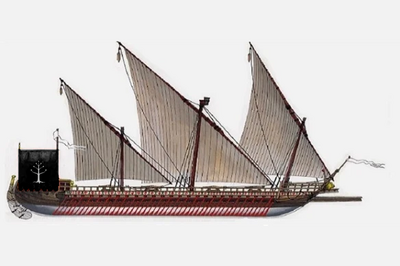
A large Gondorian dromon.
Gondor had inherited from Númenor a great naval legacy. This was maintained for the first fifteen centuries of the Third Age. However, the Kin-strife marked a turning point in this regard. The overthrow of King Eldacar by Castamir, the admiral of all of Gondor's naval forces in T.A. 1437, led to a ten-year period in which the coastal regions and navy received the lion's share of state investment, whilst the interior regions were left to rot. Eldacar then returned with an army of his Northmen kinsmen, and they were joined by armies of Gondorians from interior provinces such as Anórien. Eldacar slew Castamir and reclaimed his throne, but Castamir's sons and their forces were besieged in Pelargir, the great port of Gondor. They eventually retreated to Umbar, where they joined with the Corsairs, and troubled Gondor for many years, until their descendants died out.
The side that the navy had chosen in the Kin-strife was never forgotten. Although five centuries later, Gondor's fleet was still an impressive sight to the peoples of Lindon and Eriador (the ships of the fleet led by General (later King) Eärnur that landed at the Grey Havens to fight the Witch-king of Angmar were said to be both large and numerous), it is clear that they had already been long in decline. Umbar had inherited Númenor's naval legacy, and remained at war with Gondor for many lives of men. It was a constant threat to the coastlands of Gondor and to all traffic on the sea. In T.A. 1810, King Telumehtar assembled a large force which consisted of both ships and an overland expeditionary force which was able to successfully besiege and defeat Umbar. However, it was lost again in T.A. 1944, during the war with the Wainriders, the Haradrim and the Men of Khand. Instead of challenging the Corsairs directly at sea (and therefore investing in the navy), Gondor's rulers chose to adopt a defensive posture from this point onward, expanding existing watch-posts, coastal forts, and fortified harbours. The greatest of these was founded in 2076 - Dol Amroth, the new seat of the Princes of Belfalas. This was an expansion of a much older fortification dating from the colonial period.
Umbar is recorded as directly assaulting Gondor in the 2500s and 2700s. In both instances, these invasions were repelled by the army rather than the navy, showing how steep the decline had become. Unusually, in T.A. 2980 (twenty-six years ago), the captain Thorongil was able to gather a small fleet, attack Umbar by night, burn a great part of the ships of the Corsairs, kill the Captain of the Haven in a battle upon the quays and then withdraw his fleet with small losses. Whilst this was an impressive victory, it shows that the only way that Gondor's navy was able to pose a threat to Umbar was through stealth and subterfuge rather than in pitched battle.
It is unlikely that the navy would now be able to prevent the Corsairs from landing in Gondor - even at Linhir or Pelargir.
Taxation
Taxes are usually collected in the palace of the government of each fief, through local lords. And then fixed percentages are allocated for the state, based on the productivity of fiefs. Types of taxation include land taxes, poll taxes, and customs duties.
- Land tax is imposed on agricultural lands, mediated by landowners (usually rural/urban nobles and citizens, or free peasants who pay directly to the lord). It is paid with either money or harvest.
- Poll tax is a flat tax levied on all individuals, usually irrespective of income.
- Customs duties are levied at the import of goods across boundaries. These boundaries can be external or internal.
- Miscellaneous taxes including inheritance tax.
Total percentage of tax is expected to be 20-30% for common people.
Taxes can be paid on a guild-by-guild level, wealthier individuals would often pay more than poorer members as “charity.” Taxes could also be paid in labour over an appointed period. The Rammas was for example mostly built by workers paying their “tax” in that manner.
Communications
Relay rider network - based on the Roman system of the cursus publicus (or the Persian system of the angarium, which Rome adopted for its own system). A series of forts and stations was spread out along the major road systems connecting the regions of the Roman world. The relay points or change stations (stationes) provided horses to dispatch riders and (usually) soldiers as well as vehicles for magistrates or officers of the court. There would seem to be evidence of this in Gondor
The cost of this system would be high, and so it seems likely it would only be maintained between the major cities of Gondor, and be reserved for state/military use only. They were able to travel about 50km per day (~900 blocks at our scale). A map should be made with relay stations set at 900 block intervals between the major cities.
Beacons - Minas Tirith was the meeting point of the northern and southern beacon systems. These were an alarm system which would call upon forces from Rohan or Belfalas/Lebennin to aid the capital as soon as possible
There are a number of writing media. Daily and temporary recording uses Wax Tablet or Wood Tablet (thin and smoothed slats), or shards of pottery as scratch papers. More keepable and portable option is Papyrus produced in Ethir and Harnen (cheaper than parchment but will decay faster), or Parchment produced around the whole country. Stone Tablets may appear in the oldest libraries.
Economy
Currency and Banking
The central government plays an active role in regulating economics and trade. The state sets standard prices for certain goods, and officials inspect marketplaces to ensure these prices are kept.
The state also has a monopoly on issuing currency; the Royal Mint in Pelargir is currently the sole source of coinage throughout the entire realm. The Castar (Mirian in Sindarin) was the chief currency used within Gondor. A smaller coin was the tharni or canath, a silver coin worth a fourth of the castar. Given the state of decline, however, metallic money is likely not used in every transaction. In some city markets, people might use a credit system, with official promissory notes. Folk in the more provincial areas probably barter.
The Lords’ treasuries fund public services, and offer loans to farmers and others whose income is dependant on season.
Guilds often offer loans to their members, or members of the community. For example, they loan money to newly educated apprentices, so they could start up their own business. This would be repaid over their lifetime.
There might also be independent brokers and affluent individuals who lend money.
Trade
Trade routes
Gondor's territories have shrunk significantly over the centuries, and as a result Gondor has been mostly isolated from whatever international trade still exists. Rohan is the main trading partner of Gondor, dealing mostly in wool, livestock and horses in exchange for manufactured goods (like weapons and armour) and luxury products (like marble, jewelry, etc.). Trade with Rohan mostly goes over the Anduin, from towns in the Eastfold like Rondgeld to trading towns in Anorien like Lisclorn. From there, trade goes overland to Minas Tirith, avoiding the dangers of the east bank of the Anduin around Cair Andros and Osgiliath.
In the past, Gondor would have had extensive trade networks to the south, in Harad, and to the north with the Northmen of Rhovanion and the Vale of Anduin. These routes are long-gone, however, and their loss has been devastating to the Gondorian economy.
Gondor still maintains fairly extensive internal trade networks, capable of supporting several large towns and cities.
Most goods are transported over water, in small-to midsized riverboats and rarely on larger, oceangoing ships.
Trade facilities
- Customs offices, where customs officers do their work collecting customs dues.
- Warehouses, where trading goods are temporarily stored after arrival in a town or city.
- Docks, for the loading and unloading of cargo, and for the berthing of trading ships. These can vary in size from large docklands which would have services large fleets of oceangoing travel, to smaller quays for small riverboats.
- Roads, which are either paved or unpaved depending on the volume of traffic. Most trade would be over the water, but overland trade is still present.
- Inns, where travelling merchants can stay the night.
- Moneylenders, to provide credit to merchants.
Industry and professions
Gondor has a well-developed economy, with a relatively high degree of specialisation and urbanisation. Gondorian agriculture is capable of supporting large urban populations, in major cities like Minas Tirith and Pelargir, and in dozens of smaller towns like Lisclorn. These settlements are further supported by extensive internal trade networks, and a relatively large domestic market for luxury goods. The Gondorian economy is monetary, meaning that metal coinage is the main unit of exchange, rather than barter as is common in the less developed regions of Middle Earth. This together means that the Gondorian economy can support a large number of professions, and industry capable of producing a large number of complex manufactured goods.
In rural areas, Gondorian agriculture is dominated by large rural estates, owned by the nobility and run from a manor house. Smaller rural villages and homesteads also exist.
Here follows an exhaustive list of the professions which can be found in Gondor:
| ExpandProfession list
|
Government and infrastructure
• Governor
• Magistrate
• Tax collector
• Forester
• Letter business
• Houses of Healing offices
|
Education
• Teacher (independent or under an institution or a guild [see the educational institutions])
• Academy staff
|
Service
• Tabernae
• Mansio (roadside inn for officials but it often receives normal guests too)
• Thermopolium
• Popina
• Baker
• Cook
• Laundryman
• Barber
• Apothecary
• Sewer cleaner
• Rat catcher
• Undertaker
• Embalmer
• Necropolis keeper
• Gardener
• Servants
• Musicians and Bards
|
Commerce
• Retailer (Stays at a marketplace, buying goods from craftsmen and reselling them)
• Merchant (Travels from town to town to sell goods)
• Porter
• Ferrier
• Dockworker
• Moneylending
|
Food production
• Farmer
• Herder
• Beekeeper
• Hunter
• Gatherer
• Fisher
• Fish & Mollusk collecting/farming
• Salter
• Oil production
• Garum production
• Murri production
• Wine production
• Cider production
• Beer / Ale brewing
|
Leathercraft & animal products
• Butcher
• Furriery
• Tanner
• Leatherworkers
• Cobbler
• Saddler
• Parchmenter
• Candlemaker
• Soapmaker
|
Fibercraft
• Wool processing
• Linen processing
• Sea silk processing
• Dyer
• Common weavers
• Embroiderer
• Clothier / Tailor
• Hatmaker
• Basket weaver
• Sack weaver
• Tent weaver
• Sail weaver
• Net weaver
• Ropemaker
• Papyrus production (Practiced in the Ethir Anduin)
|
Woodwork
• Lumber camp
• Resin production
• Tar production
• Common carpenter
• Toolmaker
• Tableware craftsman
• Fan, Parasol, Umbrella craftsman
• Wood / Wax tablet maker
• Furniture artisan
• Cooper
• Wheelwright
• Cart / Wainwright
• Shipwright
• Clog maker
• Staff maker
• Broom maker
• Bowyer
• Shield maker
|
Metallurgy
• Miner and Smelter
• Ironsmith
• Bronze alloy smith
• Farrier
• Chainmaker
• Nailmaker
• Needlemaker
• Locksmith
• Fletcher
• Knifemaker
• Various weaponry artisans
• Strigilmaker
• Royal Mint (in Pelargir)
|
Ceramic and glass
• Brick / Tile factory
• Pottery factory
• Lampwright
• Glassware factory
|
Art and cosmetics
• Accessory artisans
• Sealmaker
• Iconist/Portraitist
• Frescoer
• Statuette artisan
• Instrument artisan
• Cosmetics
• Perfume
• Incense
|
Stone and construction
• Quarry workers
• Masons
• Architects
• Construction workers
|
Agriculture
Main article: Gondorian agriculture
Crops
Most of Gondor uses a two-field system due to the lack of summer rains.
The people of Anorien use a three-year crop rotation to maintain soil fertility. One field was planted in the autumn after harvest with wheat or rye (to be harvested in the late summer next year); the second field was planted with legumes or barley in the spring (to be harvested in the late summer of that year); and the third was left fallow to regenerate (and was often used to graze animals). The legumes (beans, lentils, lupins, chickpeas) strengthened the soil by their nitrogen-fixing ability and at the same time improved the human diet.
Among the grains, wheat and barley are the primary crops, with rye (represented by immature wheat), and two species of millet (setaria represented by corn and panicum represented by meadow fescue) grown as well. Legumes are a staple of the Gondorian diet, especially among the poor. As such, they should be cultivated in all peasant gardens as well as in main fields. However, they would already have been harvested some time in July.
More extensive use of fertilisation is made in the Pelennor as lands closer to cities are more valuable. As such there are fewer fields under fallow in this area.
It is important to note that the legume crop needed summer rain to succeed, and so the three-field system was less successful around the Mediterranean (a two-field system would have been used instead in the rest of Gondor)
Mills
In Roman Gaul there were various types of mills for flour. One of them was the domestic type of mill, powered by mules, oxen, etc. This technique was especially common in urban centers and towns. Water mills were introduced into Gaul by the Romans early in the first century and were especially common in the countryside. This would be an important innovation, and they would have become common near villas. There is one example of an industrial mill on the edge of “vallée des Baux,” where an artificial waterfall fed by an aqueduct powered two parallel rows of eight mills. This mill dated to the late second century and would have supplied the nearby town of Arles with flour. The mill itself was supported by a local estate.
Most mills in Gondor are domestic, powered by mules, oxen or other beasts.
Livestock
The people of Gondor keep sheep, cattle, pigs, goats and chickens for food and produce. Dairy production is a major industry in the north, providing both cheese and butter. The raising of cattle is practiced in varying degrees on fertile meadows as well as on untilled waste land. Oak, poplar and elm leaves are stored as fodder, in addition to dried grasses.
Vertical transhumance would be practiced in the mountains (bringing livestock to higher pastures in the summer and bringing them into the valleys in covered housing in the winter).
Dairy animals (which, up close to a large city, will be stall-fed rather than grazed or else transported in ‘on the hoof’ and grazed much further out) and pigs (fed by trough) don’t require much space and offer a high economic yield. Both also produce manure which is in demand near the city.
Horses can be found in Gondor as well, though husbandry would be practiced to a lesser degree owing to neighboring Rohan (the people of Minas Tirith in particular do not see many horses). These horses are kept for transportation, for drawing of carts, and for the relay rider messenger system. In addition, oxen and donkeys are used for ploughing and transport; every hamlet and village needs at least a few of each.
Woodland
Managed woodland is key for both firewood and building materials. Wood is heavy and difficult to transport, so settlements should have coppices and pollards nearby.
Horticulture
Horticulture – the intensive growing of fruits and vegetables, often in small ‘market gardens’ – is labour-intensive and offers a high economic yield for the space. Land used for horticulture can be kept under almost continual cultivation (if manured, but see above), but gardens can be fussy and demand quite a lot of labour, compared to hardier plants (like millet or wheat).
Organisation
Peasant agriculture tends to cluster in villages, with fields radiating out from the villages (which in turn, often have their own micro-garden zone and local forests for wood). Farmland within the village is typically not held as large standalone farmsteads but rather held communally, or else each family owns several small plots spread over different ecological zones (the better to be protected from the risk of a year being wet or dry or cold or whatever – if you have a little land everywhere, then probably something will grow somewhere every year).
Much of the arable land in Gondor is owned by the nobility, whose claim may be hereditary, financial, or both. A majority of the kingdom’s rural population tenants in or is employed on these estates; they are required to give a certain percentage of their crop (usually about 10%) to the landowner every year. A few middle-class citizens own tracts of land as well, employing a smaller number of peasant farmers. In other cases, small farms are independently owned by free peasants. The Pelennor Fields are one such case: farms are gifted by the state, some of them are run by retired soldiers.
Culture and daily life
Language
Adûni
Gondorian Adûni is a direct descendant of Colonial Adûni, which was a colonial development of Adûnaic influenced by various Pre-Númenórean languages. It has spread out as lingua franca all over the regions Gondor and Arnor have influenced.
By the end of Third Age, Adûni occupies daily language of every provinces where Gondor still has control. Many vestiges of Pre-Númenórean languages as substrata can be seen. Borrowings from Sindarin are even more common in Gondor than other dialects of Adûni.
Knowledge of Classical Adûnaic is still maintained among some scholars. Elites of Belfalas have kept tradition of naming in Adûnaic.
Sindarin
Gondorian Sindarin has been a fundamental language of Faithful culture. Among elites from all provinces, Sindarin is a mark of dignity and sophistication. Common people of Anórien and Belfalas still keep tradition of learning it as well.
It is another daily tongue for the mentioned population. The rest, especially urbanites of other provinces, can still understand it to some degree.
Quenya
Quenya is considered as the most prestigious, and scholarly language. A few scholars and jurists have full knowledge of it, though many elites and citizens can partly understand vocabularies.
It is the language of jurists, and the Law Codes of Gondor is written in Quenya.
Food and dining
Clothing and textiles
Festivals
Midsummer
Feast of Felling
Yule
Philosophy and belief
- People of Gondor continue to regard Iluvatar as creator of Arda and its inhabitants, who blessed them specifically and made them his "chosen people"
- Because of the evil of the King's Men, He punished them and destroyed the island of Elenna
- Since the holy mountain of Meneltarma is now lost, they can no longer openly worship Iluvatar openly
- Only private and personal worship, often consisting of facing West and praying silently
Burial
Following the custom of the royal valley on Meneltarma, Rath Dinen (Silent Street) for the kings of Gondor was founded on Amon Anor. Minas Anor, which was intended to guard the necropolis, later developed its uniqueness with the location of civic catacombs inside the city below the royal tombs.
In general, civic necropolises are found outside of the city bounds, often along one of the roads stretching out from them.
In the absence of a church, it seems likely that the guilds would handle burials. everyone but the poorest of the poor would have a stone epitaph.
The Kings and Stewards, possibly lesser lords as well, are embalmed in the style of ancient Egypt. The first step is to remove the internal organs and bodily fluids in order to slow the decomposition process, by way of an incision made on the flank. The abdominal cavity is then thoroughly rinsed with wine and filled with a mixture of spices (typically myrrh, cassia, and other aromatics). The body is placed in a bed of salt for up to 70 days, then wrapped in a linen shroud and prepared for burial.
Education
For the majority of Gondor’s rural inhabitants, education would not exceed that which they would learn at home from their parents or grandparents.
Public education is present in cities and large towns, as well as some villages in eastern Gondor. These teachers may be employed independently or belong to a guild; they generally teach in the local solma or another unused building. Merchant and Craft Guilds, meanwhile, often host private schools in their halls for the children of their members. In addition to providing general education, they allow these children to start learning their trade through apprenticeship. Children of nobility (especially those of rural manors) receive their education in their own homes, from private tutors employed by their parents.
Secondary education is only found in the cities of Gondor, in schools that include multiple teachers. Like their primary-education counterparts, they are paid for by the parents of their students. There may be several schools in one metropolis, their size and affluence depending on the social class of their attendees. The institution may belong to a specific guild like MT Scribe’s.
Any higher learning is only found in the academies of Minas Tirith, Pelargir, Linhir and Dol Amroth. People pursuing government jobs must first attend one of these universities. In addition, the military receives special education and training in history, philosophy and military tactics. Those pursuing medical education study at the Houses of Healing [see Medical Institutions].
• Elementary education is composed of Westron-Tengwar Literacy, Numeracy and a bit of Faithful-Lore (the history, philosophy and theology of Númenor). More intensive education includes Grammar, Rhetoric, Logic, Arithmetic, Geometry, Astronomy, Music and the Lore as well as Sindarin. Quenya and Law are taught at academies; aside from the citizens of Minas Tirith, Dol Amroth and the adjacent townlands, this education would only be available to the upper class.
Medicine
Medicine in Gondor is highly advanced compared to the rest of Middle-earth, at least on par with Medieval Europe. The Dunedain and their descendents learned much about healing from the Elves, greatly surpassing human understanding. This advanced knowledge has shaped public policy, especially regarding water management (See the corresponding section here). There are public baths in Minas Tirith and Lisclorn (List others as we add them. Include a brief description). Wealthy families have private baths in their manors.
Medical practice is fairly holistic, with heavy emphasis placed on diet and exercise. Overall the people of Gondor have extensive knowledge of herb-lore, using a wide variety of plants in tonics or salves [see below]. In some cases, doctors practice bloodletting, often with leeches, and cautery. Surgery is rather limited, only undertaken when necessary. For antiseptics, they use substances like wine, saltwater, vinegar and rose oil. Hemlock, henbane, nightshade, opium and hemp are used to treat pain, and might even act as a general anaesthetic.
Doctors are generally highly respected, seen as masters of lore and knowledge. There are a variety of ranks and professions; the oldest and most experienced physicians are appointed as Warden of a House of Healing or as the Steward’s private doctor. Aside from this, there are surgeons, barber-surgeons, specialists (such as dentists and oculists), herb-masters, midwives, nurses, and cleaners of surgical equipment. Those wishing to become doctors would train at the Houses of Healing, also attending public lectures held therein.
The Houses of Healing are public hospitals, located in every major city and largely funded by local guilds. In addition to clinics and surgeries, they provide housing for the blind, the lame, the elderly and mentally ill, as well as temporary shelter for widows and orphans. Their structure draws heavily from hospitals of the Byzantine Empire, as well as medieval Islamic Bimaristans. They include open wards, always separate for men and women, as well as private quarantine rooms. Most can only house 100 patients or fewer, but the hospital of Osgiliath might have been able to hold over 200 people.
Houses of Healing also require operating rooms with good drainage, an archive, an herb garden, a pharmacy for preparation of herbal remedies, a kitchen, and storage spaces. Some major Houses of Healing can have a solma for the aforementioned medical lectures, as well as for socialization and entertainment for the patients. These solmar can feature icons of past kings, who have always been associated with healing. The hospitals in Osgiliath and Pelargir might also hold anatomical theaters for educational dissections.
In addition to the materials required for medicine, Houses of Healing also need operating tools (mostly probes, knives and saws), sutures, linen bandages, wooden splints, vials for observing bodily fluids, and timepieces (probably sand timers) to measure pulse and breathing rate.
There should be military hospitals incorporated into fortifications such as Cair Andros, usually in a quiet corner along the outer wall.
Medicines and remedies
The following herbs are commonly used for medical purposes, and can be grown in the gardens at Houses of Healing: aloe, betony, birthwort, celandine, centaury, coriander, dittany, fennel, garlic, gentian, ground ivy, licorice, mugwort, peach bark, rhubarb, rue, sage, southernwood, St. John’s wort, tarragon and wormwood. There are also a number of goods that would have to be acquired from elsewhere: barley, cheese, celery, hemp, honey, milk, rye, turnips and wine.
(footnote)This list draws from the medieval remedies found in the Red Book of Hergest
Recreation
Cultural institutions
A solma is a major place of social gathering and interaction. There are many types of it, from personal ones of manors to public ones in guildhalls and near plaza.
Theatre and music would be played in the solmar/courtyards connected to the libraries. Old artifacts would be shown in the library and the solma connected to the complex.
Well-off People go to vacation/tour spots around the country like Lossarnach, or Dol Amroth
The guilds would hire mummers and bards to sing and play stories related to Gondorian history.
Regions
Gondor is divided between several semi-autonomous regions. These are the following:
Anfalas
Main article: Anfalas
The Langstrand, in the south-west.
Anórien
Main article: Anórien
Surrounding Minas Tirith and north of Ered Nimrais.
Belfalas
Main article: Belfalas
The peninsula jutting out from the southern coast of Gondor ruled by the Prince of Dol Amroth.
Ethir Anduin
Main article: Ethir Anduin
The estuary of the River Anduin.
Ithilien
Main article: Ithilien
The lands across the Anduin from Minas Tirith.
Lamedon
Main article: Lamedon
North of the Ringló.
Lebennin
Main article: Lebennin
The land south of Lossarnach and north of the Anduin.
Lossarnach
Main article: Lossarnach
In the mountain vales south-west of Minas Tirith.
Morthond
Main article: Morthond
South of Erech.
Pinnath Gelin
Main article: Pinnath Gelin
The hills north of Anfalas and east of the river Lefnui.
Tolfalas
Main article: Tolfalas
The isle in the Bay of Anduin.
Additionally, Gondor held or had held the following regions at certain points in its history:
Harondor
Main article: Harondor
Contested between Gondor and the forces of Harad and Umbar.
Calenardhon
Given to the Éothéod and became Rohan.
Enedwaith
The timberlands of Gondor (shared with Arnor), which were never really populated and soon abandoned.
Rhovanion
Never fully under the control of Gondor but under Gondorian influence at certain times during the Third Age.
Haradwaith
A tributary of Gondor for a while.
Cities
Cities in Gondor include:
- Calembel
- Dol Amroth, the seat of Princes on the coasts of Gondor
- Linhir
- Minas Tirith (originally named Minas Anor), the seven-tiered citadel of the Kings of Gondor
- Minas Ithil, conquered by the Ringwraiths and renamed Minas Morgul by the Gondorians
- Osgiliath, the ancient capital of Gondor
- Pelargir, the greatest and most ancient of the havens of Gondor
References


